 |
BASIC NOTIONS - here I take for granted that you know concepts about energy, power, efficiency, fluence, and want give ideas about the typical LLLB source properties.

This image give a rought idea of a solid state laser source, which emits a beam of polarized light. The factors involved are
- the beam power: 5mW referring to a done beam diameter of about 3 mm [W]
-
| the area of the beam section:A 7.065 |
mm |
2 |
or 0.07065 |
cm |
2 |
measured with by intersection of a plane perpendicular to the beam axis at a given distance from the beam source
- the light flow or specific power: F = [W/A] that is in this case is 5/70.65 =
0.0708 [W / sqcm]
- the treatment time T in seconds [s]
- the surface area S of the treated zone in sqcm
- the specific dose that is F x T in this case 0.0708 [J / (sqcm x s)]
- the dose for a single source is then F x T x S it is (light flow x time x surface area)
For each type of disease it is necessary to fix
the following parameters
- Unit dose of radiation
- duration of a session
- Number of sessions required (then the total energy supplied)
- Distance between two successive sessions
- the points where to apply the radiation
|
 |
ACTION OF SOME TYPE OF LASERS
This below here is a logarithmic scale diagram that provides the fluence (here called power density) as a function of the application time. This gives an idea of the nteraction time (duration in second) of a laser beam to take its effects
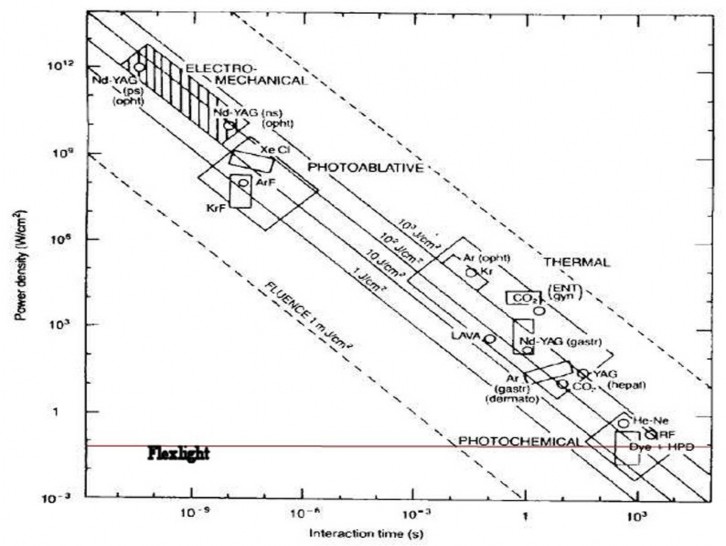
We see here that thermal and photoablative lasers have greater power density, and lowest time to take effect - let's say les than a 1/100 or 1/1000 of a second, while instead in case of LLLB the minimum duration of application is 10 minutes; 5 of which are required for the start of the biochemical reaction in the organic cells subjected to radiation, and 5 minutes the minimum treatment to obtain a significant effect of the biochemical reaction.
The luminous dose increases with the number of emitters, so increasing the number of emitters one can decrease the time required for an application. This is the unique specific characteristi of this trim, the system to maximize productivity. But the use of more emitters is not yet been experienced.
|
 |
HOW TO OPERATE
To perform the treatment one should point and keep the laser light on the needed zone minimum 10 minutes, unless the calculated required time should be different .
| 1) |
Joint |
2) |
Sternum / solar plexus |
3) |
Biceps |
4) |
Elbow (anterior) |
5) |
Forearm |
6) |
Genitals |
7) |
Cuadriceps |
8) |
Joint (side) |
| 9) |
Dorsal / ribs |
10) |
Elbow joint |
11) |
Wrist |
12) |
Sciatic nerve pass |
| 13) |
Articulation |
14) |
blades |
15) |
Column-vertebrae |
16) |
Elbow |
| 17) |
Sacrum-Lumbar |
18) |
Buttocks |
19) |
Anal and perianal |
20) |
Cervical spine |
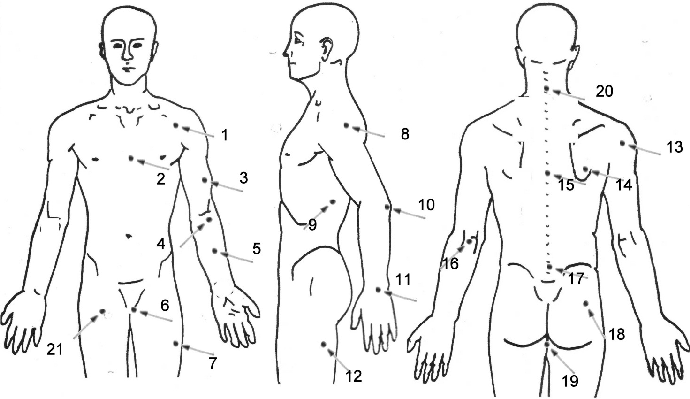
| 21) |
Saphenous pass |
22) |
Heel |
23) |
Feets plant |
24) |
Fingers Base |
25 |
Knee-Muscle Insert. |
26) |
Knee (backside) |
27) |
Calf-side |
28) |
Calf-side |
| 29) |
Calf- backside |
30) |
Ankle - Front |
31) |
Metatarsus |
32) |
AchillesTendon |
| 33) |
Mount of Venus |
34) |
Carpal tunnel |
35) |
Fingers Base |
36) |
AchillesTendon |
| 37) |
Heel (back) |
38) |
Arch of the foot |
39) |
Big toe Articulation |
40) |
Ear lobe -rear |
| 41) |
Hand snuff |
42) |
Wrist |
43) |
Pinky fore finger |
44) |
Skull vortex |
| 45) |
Frontal lobes |
46) |
Occipit |
47) |
Trigeminal area |
48) |
Nasal sinus |
| 49) |
Lips |
50) |
Nasal sinus (2) |
51) |
Third eye area |
|
|

During a treatment one should particularly insist to keep the light spot onto the aching area, until the pain stops or untill the planned duration ends. |
 |
TREATMENTS DURATION
The table below has been proposed by the researcher and is not a mandatory requirement of times, but a simple basic orientation for those who could want repeat the experiences.These data refer to a single laser source with actual power from 1 to 5 mW 635nm solid state laser or He-Ne gas laser .

I'm not able to refer if the light polarization type gets different results. If someone knows it please let me know. Thanks |
 |
PRODUCTIVITY
The previous table shows the suggested data for the treatments carried out with a single emitter, indicating the dose that should be used.
Assuming that the activity of LLB laser depends on the cumulative administered dose, the treatment times are lower depending on the number of emitters.
Then, maintaining the minimum treatment duration of about 600 seconds, productivity would increase, decreasing the minimum duration of the single treatment.
The number of seats and the distance between two seats would remain the same, because the body still needs much time to repair itself naturally.
The patient's advantage would be the shorter duration of the single session, while a single laser operator could perform a greater number of sessions.
| EXAMPLE: TABLE OF EQUIVALENT TIMES (minutes) |
|
| Emissors number |
1 |
2 |
3 |
4 |
5 |
|
| t = equivalent exposure time |
T= 30,00 |
17,50 |
13,30 |
11,25 |
10,00 |
| 30’ |
17’ 30’’ |
13’ 20’’ |
11’ 15’’ |
10’ |
|
| R = ratio t / T |
1 |
0,58 |
0,44 |
0,37 |
0,33 |
|
Condition 1 : if the calculation gives t <10' then let's assume that t = 10'
Condition 2: be aware when increasing the specific power, it is take care that the beam power per unit of area must not exceed the maximum secutirity permissible value..
In other words, a 30-minute treatment with a single emitter is equivalent to a 10-minute treatment with 5 emitters.
To calculate values the following equation is used,
t = 5 + (T-5) / N where T is the time with one emissor, N the emissors number, t the treatment time
using N emissors ( for N = 1 we see that T = t)
R = 5 (N-1) / (t N) + 1 / N where N is the emissors number, R is the ratio t/T
It is quite obvious clear that a given number N of emitters could be replaced by a smaller number n<N of more powered emitters. provided that the specific power (W / sqcm) does not exceed the maximum indicated to avoid damaging the tissues.
We leave you the pleasure to perform the calculations by reducing the number of emitters and increasing the light output.
|
 |
MY MULTIPLE-HEAD LASER
I built this machine in 2008-2009, assembling the components. I designed and built a simple power supply system of the laser tubes using one type of adjustment in the tension of the emitted power.
In fact I thought that is needed the intensity reduction in the case thtat one should hit the more sensitive areas, such as tongue, or open wounds.
Being a mechanical engineer with quite limited e-notions, I did not design a system with the current regulation, which, however, I plan to do in future.
Moreover, the experience has shown me that the power supply circuit should be simpler, integrated in the console,. and that the modern times require to add some instruments to measure the time, the power, and the dosis. And perhaps a programmable logic to fix these factors according the treatment., and also a mechanically controlled pointing device, if the assembly commercial cost should be affordable.
My rough primitive and self made device (see photos) consists of:
- Console with rough controls and indicators. At back we have an adapter for the battery charger and the plug for the four pole cable to bring power to the emitters.
- Cable about 150 cm long, with two identical audio type adapters at each end.
- PVC head with housing for 5 emitters and plug for the quad-polar cable adapter.
- Each LED emitter has the power of 5mW at the voltage of 4.5V.

CONSOLE

CONSOLE REAR-VIEW
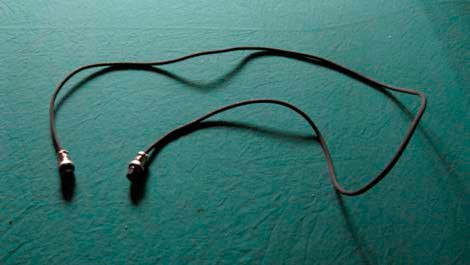 |
 |
| CABLE |
PARTICULAR |
| |
|
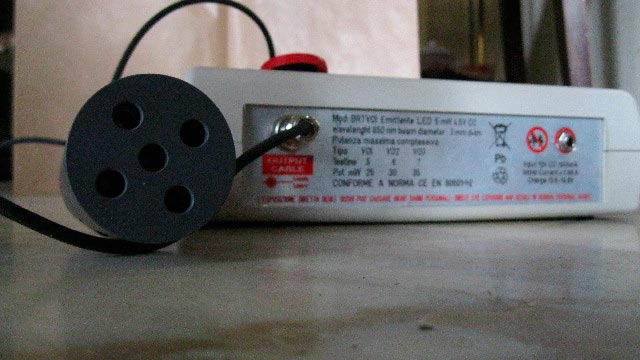 |
| ASSEMBLY - REAR VIEW |
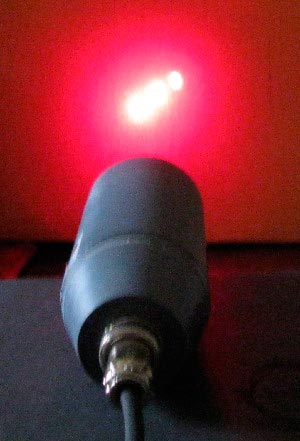 |
This is the first turn on and testing of my device. Place: my home, table of the dining room.
DATA
Total current : 60-65mA cc
Total Power :about. 180 - 210mw
laser efficiency about 10%
User power: 15 -20 mW
single emissor 3 - 4mW
|
| |
| Note: i left this device to Dr. Barrhoilet , in Santiago de Chile to have a feed back of experiments, but until now I didn't had news. My daughter Dr. Mariarita Bertuzzi de Prat, UANDES university teacher and administator who works an live in the same city said me that she couldn't have this device back, nor have any news more from him. |
|
 |
Bibliography
- Kozhekin VV, Reshel'ko OA, Tkachev AM, Zhuk SA. Intravenous laser irradiation of blood and oxygen transport function. Anesteziol Reanimatol. 1995 Jan-Feb;(1):42-3.
- A,Rigau J, Waynant RW, Ilev IK, Anders JJ. The electric field induced by light can explain cellular responses to electromagnetic energy:
A hypothesis of laser mechanism. Journal of Photochemistry and Photobiology B: Biology 82 (2006) 152–160.
- Garfinkel D. Studies on pig liver microsomes. Enzymic and pigment composition of different microsomal fraction. Arch Biochem Biophys 77: 493-509 (1958).
- Mester, A.R., Nagylueskay, S., Mako, E., et al. (1998). Experimental immunological study with radiological application of lowpower laser, in: Laser in Medicine.
- W. Waidelich (ed.). Berlin: Springer-Verlag, pp. 502–512.
- Mester, E., and Jaszsagi-Nargy, E. (1973). The effects of laser radiation on wound healing and collagen synthesis. Studia Biophys. Band 35, 227–230.
- KujaJ, Zavodnik L, Zavodnik I, Bryzewska M. Low-intensity near-infrared laser radiation-induced changes of acetylcholinesterase activity of human erithrocytes. J Clin Laser Med Surg. 2003 Dec;21(6):351-5
- Iijima K, Shimiyama N, Shimiyama M, Mizuguchi T. Effects of low He-Ne laser on deformability of stored human erithrocytes. J Clin Laser Med Surg. 1993 Aug;11(4):185-9
- L. Bolognani, M. Cavalca, C. Magnani, N. Volpi, ATP synthesis catalysed by myosin ATPase: effect of laser and e.m. field, Laser & Technol. 2 (3) (1992) 115–120.
- A. Ehrlicher, T. Betz, B. Stuhrmann, D. Koch, V. Milner, M.G. Raizen, J. Kas, Guiding neuronal growth with light, Proc. Natl. Acad. Sci. USA 99 (25) (2002) 16024–16028.
- Laser Prague 2007 Congress Abstract Books.
- Dott. Gian Franco Franchi - Applicazioni LLLT sui tessuti molli
- Dott.ssa Daniela Ingletto Ospedale San Camillo Forlanini - Roma - Dip.to Medicina Interna - Laser terapia medica - L'evidenza clinica in riabilitazione - Laserterapia
The item 8 give infos about a He-Ne laser, which has the same light wavelenght as my own. |
| |